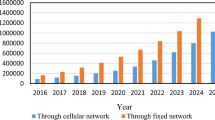Abstract
The analysis and design of relay protocols is a hot issue in 3GPP Long Term Evolution—Advanced. In this paper, we discuss interference cancellation in a multiuser MIMO environment using Amplify-and-Forward (AF), Decode-and-Forward (DF) and De-Modulate-and-Forward (DMF) as relay protocols, and using Thomilson Harashima Precoding and Dirty Paper Coding as precoding techniques, with Zero-Forcing, Minimum Mean Square Error, Successive Interference Cancellation and Ordered Successive Interference Cancellation detection techniques. By using a combination of classical precoding schemes and detection techniques with weighted matrix, we propose a new interference cancellation technique that is capable of cancelling interference. The interference cancellation is managed by AF, DF and DMF relay node protocols and the interference free codeword is transmitted to the selected User Equipment. The proposed algorithm when used with DMF protocol shows best performance, compared to the conventional system or the no-relay system case, it gives best performance. The observation results shows that DMF protocol gives the best results for BER and Throughput performance in a high interference environment.














Similar content being viewed by others
References
Pabst, R., Walke, B. H., & Schultz, D. C. (2004). Relay-based deployment concepts for wireless and mobile broadband radio. IEEE Communications Magazine, 42(9), 80–89.
Peters, S. W., Panah, A. Y., Truong, K. T., & Heath, R. W., Jr. (2009). Relay architectures for 3GPP LTE-advanced. EURASIP Journal on Wireless Communications and Networking, 2009, 14.
Sesia, S., Toufik, I., & Baker, M. (2009). LTE, the UMTS long term evolution: From theory to practice. New York: Wiley.
Telatar, E. (1999). Capacity of multi-antenna Gaussian channels. European Transactions on Telecommunications, 10, 585–598.
Wang, B., Zhang, J., & Høst-Madsen, A. (2005). On the capacity of MIMO relay channels. IEEE Transactions on Information Theory, 51(1), 29–43.
Tang, X., & Hua, Y. (2007). Optimal design of non-regenerative MIMO wireless relays. IEEE Transactions on Wireless Communications, 6(4), 1398–1407.
Munoz-Medina, O., Vidal, J., & Augstın, A. (2007). Linear transceiver design in non-regenerative relays with channel state information. IEEE Transactions on Signal Processing, 55(6), 2593–2604.
Huang, Y., Yang, L., & Ottersten, B. (2010). A limited feedback joint precoding for amplify-and-forward relaying. IEEE Transactions on Signal Processing, 58(3), 1347–1357.
Hardjawana, W., Vucetic, B., & Li, Y. (2008). Cooperative precoding and beamforming in co-working wlans. In ICC proceedings (pp. 4759–4763).
Hardjawana, W., Vucetic, B., & Li, Y. (2009). Cooperative precoding and beamforming for co-existing multiuser MIMO systems. In IEEE ICC 2009 proceedings (pp. 1–5).
Foschini, G. J., Karakayali, K., & Valenzuela, R. (2006). Coordinating multiple antenna cellular networks to achieve enormous spectral efficiency. IEEE Proceedings on Communications, 153(4), 548–555.
Tomlinson, M. (1971). New automatic equalizer employing modulo arithmatic. IEEE Electronic Letters, 7, 138–139.
Chae, C. B., Tang, T., Heath, R. W., Jr., & Cho, S. (2008). MIMO relaying with linear processing for multiuser transmission in fixed relay networks. IEEE Transactions on Signal Processing, 56(2), 727–738.
Zhang, R., Chai, C. C., & Liang, Y. C. (2009). Joint beamforming and power control for multiantenna relay broadcast channel with QoS constraints. IEEE Transactions on Signal Processing, 57(2), 726–737.
Behbahani, A. S., & Eltawil, A. M. (2009). Amplify-and-forward relay networks under received power constraint. IEEE Transactions on, Wireless Communications, 8(11), 5422–5426.
Antoniou, A., & Lu, W. S. (2007). Practical optimization: Algorithms and engineering applications. New York, NY: Springer.
Dietrich, F. A., Breun, P., & Utschick, W. (2007). Robust Tomlinson-Harashima precoding for the wireless broadcast channel. IEEE Transactions on Signal Processing, 55(2), 631–644.
Fischer, R. F. H. (2002). Precoding and signal shaping for digital transmission. New York: Wiley.
Costa, M. H. M. (1983). Writing on a dirty paper. IEEE Transactions on Information theory, 29, 439–441.
Caire, G., & Shamai, S. (2003). On the achievable throughput of a multiantenna Gaussian broadcast channel. IEEE Transactions on Information Theory, 49(7), 1691–1706.
Fischer, R. F. H., Windpassinger, C. A. (2003). Improved MIMO precoding for decentralized receivers resembling concepts from lattice reduction. In Global Telecommunications Conference ’03. IEEE (Vol. 4, pp. 1852–1856).
Fischer, R. F. H., Huber, J. B., & Windpassinger, C. A. (2003). Precoding for point-to-multipoint transmission. In Eight international workshop on signal processing for space communications. (pp. 137–144).
Laneman, J. N., Tse, D. N. C., & Wornell, G. W. (2004). Cooperative diversity in wireless networks: efficient protocol and outage behavior. IEEE Transactions on Information Theory, 50, 3062–3080.
Acknowledgments
This research was supported by the Basic Science Research Program, through the National Research Foundation of Korea (NRF), funded by the Ministry of Education (2013R1A1A2007779). This research was supported by the MSIP (Ministry of Science, ICT & Future Planning), Korea, under the ITRC (Information Technology Research Center) support program (NIPA-2013-H0301-13-3005), supervised by the NIPA (National IT Industry Promotion Agency).
Author information
Authors and Affiliations
Corresponding author
Rights and permissions
About this article
Cite this article
Malik, S., Moon, S., Kim, B. et al. Design and Analysis of an Interference Cancellation Algorithm for AF, DF and DMF Relay Protocol in Multiuser MIMO Scenario Based on the LTE-Advanced System. Wireless Pers Commun 75, 775–797 (2014). https://doi.org/10.1007/s11277-013-1391-6
Published:
Issue Date:
DOI: https://doi.org/10.1007/s11277-013-1391-6




